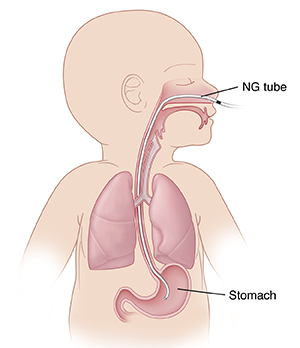When Your Child Needs a Nasogastric (NG) Tube
If your child is having trouble swallowing food or liquids safely, the healthcare provider may advise tube feeding. Tube feeding is often done with a nasogastric (NG) tube. This is a soft, thin tube put through your child’s nose and down into the stomach. It sends liquid food directly to the stomach. Liquid food given through the NG tube is digested the same as food eaten normally. The NG tube may look uncomfortable. But it shouldn't be uncomfortable for your child.

Note
Take care to keep the tube from becoming a strangulation risk to your child. Follow your healthcare team's advice on how to secure the tube safely.
Why an NG tube is used
An NG tube is often used for many reasons. For instance, it may be used if your child:
-
Needs short-term help getting nutrients or medicine
-
Isn't growing properly on regular food
-
Has trouble swallowing
-
Has an infection or is recovering from surgery and can’t eat food for a short time
-
Needs extra nutrition in addition to regular feeding
An NG tube is only meant to be used for a short time. Your healthcare provider will talk with you about options if a long-term tube is needed.
Your child's NG tube may need to be replaced regularly. Ask your child's healthcare provider how often the NG tube needs to be replaced.
Replace NG tube: ______________________________
Contact information to keep handy
Ask for phone numbers to call if you need help. Also make sure you have the phone number for your child’s medical supply company. You will need to order more supplies for your child in the future. Write all of these phone numbers below.
Healthcare provider phone number: ____________________________________
Home health nurse phone number: _____________________________________
Medical supply company phone number: __________________________________
Caring for the NG tube
The tube will be first inserted in the hospital. You may find that it's easier to care for than you think. You’ll be shown how to correctly insert, remove, and care for the NG tube at home. You will learn how to check to make sure the tube is in the right place before feedings, fluids, or medicines are given. You will be taught how to use pH paper to check placement.
Feeding your child
You will need to feed your child through the tube. You will be shown how to do this before your child is discharged from the hospital. If you need more help, talk with the hospital about how to arrange a home health nurse to help you.
Checking tube placement with pH paper
Every time you feed your child, you will need to make sure the NG tube is in the correct place. The end of the tube must be in your child’s stomach, not in the lungs or throat. To check if the tube is in place, you will draw some liquid from the stomach and test the pH of the liquid. Do this check before each feeding: Check the pH of the liquid from the stomach using pH paper. Stomach (gastric) pH should be 1 to 5 if your child is not taking a proton pump inhibitor or H2 receptor antagonist. There are other things that can increase pH. Follow your provider's specific instructions.
Types of feeding
There are 2 types of feeding with an NG tube. Your child may have 1 or both types of feeding. They are:
-
Continuous feeding. Liquid food is dripped slowly through the tube for part or all of a day. This type of feeding is only done using a pump. The amount of food to be given and time frame are often set on the pump for you. Don't change pump settings unless you’re told to do so.
You will need to stop the feeding for a short time each day to check tube placement with pH strips. Follow your provider's specific instructions on how to do this:
______________________________________________________________________
-
Bolus feeding. This is a meal-sized amount of liquid food given through the tube a few times a day. Bolus feeding is given using a syringe or a pump. Your child’s healthcare provider or home health nurse will tell you how much liquid food to use for each feeding. You will also be told how often to feed your child.
For bolus feeding, fill in the numbers below:
Feed your child on this schedule: ____________________________________________
Give this much at each feeding: ______________________________________________
When to call the healthcare provider
Call your child's healthcare provider right away if any of these occur:
-
You’re not able to place the tube.
-
The skin around the tube site has redness, swelling, leaking fluid, or sores.
-
You see blood around the tube, in your child’s stool, or in their stomach contents.
-
Your child coughs, chokes, or vomits while feeding.
-
Your child’s belly looks bloated or feels hard when gently pressed.
-
Your child has diarrhea or constipation.
-
Your child has a fever 100.4°F ( 38°C) or higher, or as directed by the healthcare provider.